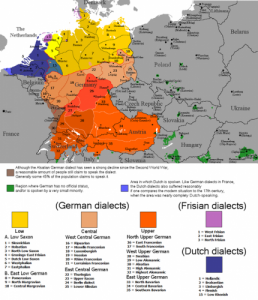How Many Dialects of German Are There?
By Sarah-Claire Jordan
 German may not be the most widely spoken language in the world, but that doesn’t mean it isn’t without its dialects and varieties. It is the official language of Germany and Austria as well as one of the official languages in Belgium, Switzerland, Luxembourg, and Liechtenstein. All dialects of German have their origins in the languages spoken by the various Germanic tribes, which means there isn’t a high level of mutual intelligibility between some of them.
German may not be the most widely spoken language in the world, but that doesn’t mean it isn’t without its dialects and varieties. It is the official language of Germany and Austria as well as one of the official languages in Belgium, Switzerland, Luxembourg, and Liechtenstein. All dialects of German have their origins in the languages spoken by the various Germanic tribes, which means there isn’t a high level of mutual intelligibility between some of them.
That being said, it is important to know the difference between what linguists consider “dialects” and what they consider “varieties”. These variations on the standard German dialect are all mutually intelligible and only have slight differences in phonology and other characteristics. Varieties of German are not super interesting when you compare them to German dialects, with some so different they’re practically different languages.
Dialects Spoken in Germany
Within Germany, the different dialects can roughly be divided into two categories: Low German and High German. These categories are really just two parts of the dialect continuum and are named after the highlands and lowlands of Germany rather than the social classes that speak them.
Low German is made up of Dutch Low Saxon, West Low German (also known as Low Saxon), and East Low German. Dutch Low Saxon is spoken in the Netherlands, hence the word “Dutch” in the name. West Low German/ Low Saxon is spoken in the Netherlands as well, along with northwestern Germany and Denmark. East Low German can be heard in northeastern Germany and also in some parts of Poland. Each of these dialects has its own varieties.
High German includes Central German, High Franconian, and Upper German. Central German is spoken in the southeastern region of the Netherlands, in eastern Belgium, parts of France, Luxembourg, and in the region of Germany between the River Main and the southern part of the Lowlands. It includes High Prussian, North Upper Saxon, and North Hessian, to name a few. Upper German dialects can be heard in southern Germany, the Alsace region of France, Austria, Liechtenstein, and the German-speaking areas of Italy and Switzerland. High Franconian acts like a bridge between the two main High German dialect groups.
Dialects Spoken Outside of Europe
Crossing the Atlantic, you will find that German has traveled and stayed in some areas. Amana German is a dialect of German spoken by a German religious community that settled in Iowa. In Texas, specifically San Antonio and Austin, German used to be the most common language used in schools, businesses, and even the church. Some of this Texas German dialect has lingered. Lagunen-Deutsch is spoken in Chile, and has adopted many features of Chilean Spanish. In Brazil, there are pockets of the population who speak Brazilian German, also known as Riograndenser Hunsrückisch.
As you can see, there are many more types of German than most people would imagine. At Alpha Omega Translation, every translation and interpretation team member is an expert in their language, which would include knowing all of the different varieties and dialects of German.
For an overview of our translation expertise, visit our telephone interpreting service page
Category: Foreign Language








